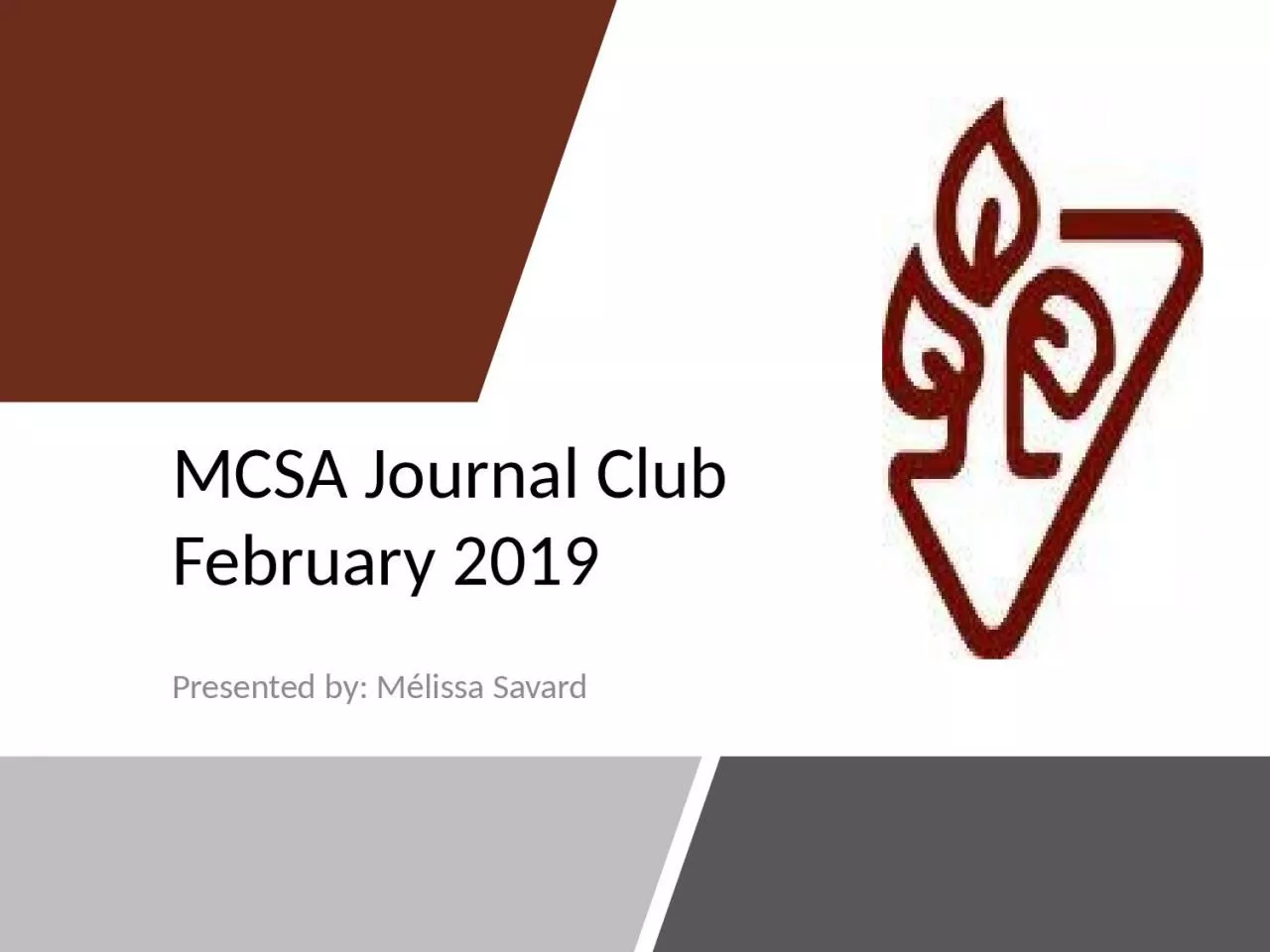

Presented by Mélissa Savard White Matter Alterations and Cognitive Loss in Frontotemporal Dementia Data from Frontotemporal Lobar Degeneration Neuroimaging Initiative Background Prevalence ID: 1048669
Download Presentation The PPT/PDF document "MCSA Journal Club February 2019" is the property of its rightful owner. Permission is granted to download and print the materials on this web site for personal, non-commercial use only, and to display it on your personal computer provided you do not modify the materials and that you retain all copyright notices contained in the materials. By downloading content from our website, you accept the terms of this agreement.
1. MCSA Journal ClubFebruary 2019Presented by: Mélissa Savard
2. White Matter Alterations and Cognitive Loss in Frontotemporal Dementia Data from : Frontotemporal Lobar Degeneration Neuroimaging Initiative
3. BackgroundPrevalence1-26 per 1000003-26 % early onset dementia (< 65y)Neuropathologyneuronal loss, gliosis, and microvacular changesGeneticFamilial history (40%),Autosomal dominant (10%)Proteinopathymicrotubule-associated protein tau (MAPT)TAR DNA-binding protein with molecular weight 43 kDa (TDP-43)Fused-in-sarcoma (FUS) protein
4. Symptoms are overlapping amongst variants
5. GM and WM alteration in FTD (Agosta et al. 2015)WM damage is more extensive than GM damageProtein propagation would result in a convergence of damage to the core (frontal) network, with differences (amongst variant) due to the focal site of onset bvFTDN=14nfvPPAN=11svPPAN=12GM (VBM)WM (FA)Core Network
6. AimsUsing Diffusion Weighted Imaging (DWI): Extend the understanding of WM microstructure in FTD variants and it’s relationship with cognition Explore the disconnection syndrome hypothesisInstead of being localized in specific regions of the brain, higher functions resulted from associative (WM) connections between brain regions (Wernicke (1874), Dejerine (1892), Geschwind (1965), etc...)
7. How diffusion MRI works
8. DWI methodConstrained Spherical Deconvolution (CSD) (Tournier2007) estimates a white matter fibre Orientation Distribution Function (fODF)
9. Measures 1. Fixel-Based AnalysisNon linear registration to template allows to get different White Matter Fibres measures -Step 1 : reorient fODF : Fibre Density (local measure)-Step 2 : modulate fODF : Fibre Cross-Section (macroscopic measure)Stats :-Test correlations between predictor and FD and FC across subject for each voxel -Correct for multiple comparisons (bootstrap + anisotropic clustering)
10. Measure 2. Structural Connectivity1. Seeding 20 M tracks2. Filtering tracks~ 300kGM regionsGM regions3. Applying GM atlas4. Counting tracks GMi to GMi5. Structural Connectivity
11. Connectivity matrix statsRun repeated GLMs across subjects for each connectionsCorrecting for multiple comparison (FDR < 0.05)BrainNet ViewerUncorrected T valuesT values (pass fdr)Uncorrected T values (all connections)GM regionsGM regionsGM regionsGM regionspasspass
12. Demographics and cognitive measure1. California Verbal Learning testEpisodic verbal learningMemory (encoding + retrieval)2. Maximum Digit recall SpanVerbal Ability Executive function3. Verbal Fluency : N Correct Word Working memoryExecutive function
13. Fiber Density and FTD variants (vs CN)Overlapping damages in uncinate and inferior longitudinal fasciculiBV > frontal WM SV > hippocampal part of cingulum and temporal WMPNFA > Corpus callosum and Fronto-Occipital fasciulus
14. Fiber Cross-Section and FTD variants (vs CN)Same as FD but more severe effect
15. Regions affected : Left uncinate fasciculus, Inferior Longitudinal Fasciculus, hippocampal part of cingulum Overlapping fibres responsible for both short and long term recall ?
16. Regions affected : Central part of Corpus callosum + Fronto-occipital fasciculus
17. Regions affected : Superior longitudinal Fasciculus, Inferior Fronto-occipital fasciculus (animal only), some central corpus callosum ( d words only).
18. Connectivity and FTD Variants *ipsilateral connections only : 20 % more affected is shownmedTC x supTCinfTC x thalamusfusiform x infTClatOFC x supTC...Insula x Pars orbitalisInsula x Pars opecularisrmidFC x thalamusCaudate x putamen...Insula x pars orbitalisinfTC x thalamusInsula x pars triangularisInsula x pars opercularis...
19. Connectivity and cognition*ipsilateral connections only : 20 % more affected is shownVF : animalInsula x Pars opercularisinfTC x thalamusVF : d wordsmidTC x supFCpars orbitalis x thalamusVL : 30 secinfTC x thalamusSupTC x latOFCVL : 10 min delaySupTC x latOFCinfTC x thalamusDS: ForwardsupFC x SupramarginalmidFC x SupFCDS: BackwardsupFC x midFCsupFC x midTC
20. SummaryFibre cross section (FC) appears more affected than fibre density (FD)Demyelination?Larges association fibres damages were associated lower cognitive scoresUncinate fasciculus connects hippocampus and amygdala to orbitofrontal cortexInferior Longitudinal FasciculusConnects anterior temporal lobe and the extrastriate cortex of the occipital lobe,Object, face and place processing, reading, lexical and semantic processing, emotion processing, and visual memory.Cingulum (hippocampal part)connects to the hippocampustakes memory information and integrates this to other parts of the brainCorpus callosumconnects the left and right cerebral hemispheresFronto-occipital fasciculusStructural connectivity adds information about disconnection between specific GM areasInsula x Pars Opercularis (part of Brocas area) disconnection strongly associated to BV and PNFA variants and to worse verbal fluencyInf. temporal gyrus x thalamus disconnection strongly associated to SV and PNFA variants and to worse verbal learning and verbal fluencySup. temporal gyrus x lat orbitofrontal disconnection strongly associated to SV variants and to worse verbal learningFronto x parietal and interhemisperic (not shown) disconnection strongly associated to worse digit spanHow to combine regional GM info to structural connectivity ??
21. Same mutation can cause different disease ??
22. Connectivity-based fixel enhancement
23.